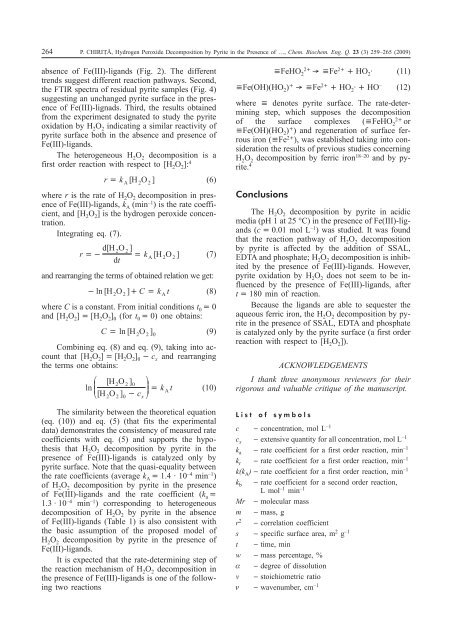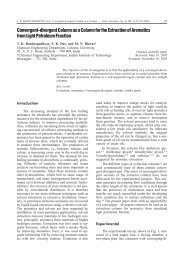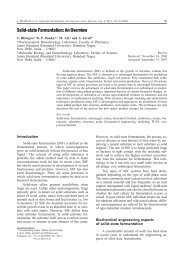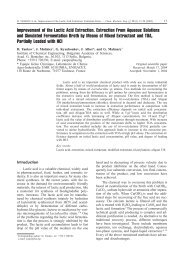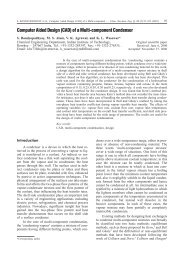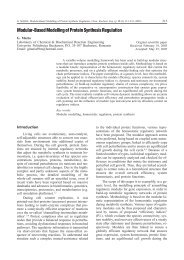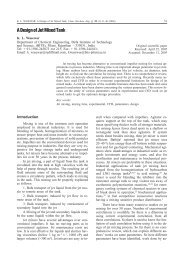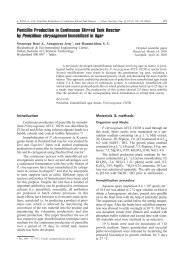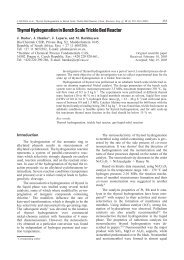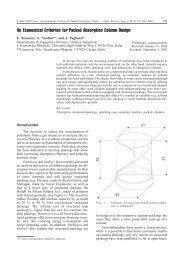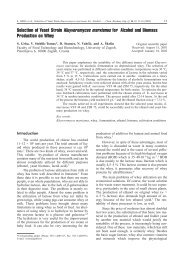Hydrogen Peroxide Decomposition by Pyrite in the Presence of Fe ...
Hydrogen Peroxide Decomposition by Pyrite in the Presence of Fe ...
Hydrogen Peroxide Decomposition by Pyrite in the Presence of Fe ...
You also want an ePaper? Increase the reach of your titles
YUMPU automatically turns print PDFs into web optimized ePapers that Google loves.
264 P. CHIRIȚÃ, <strong>Hydrogen</strong> <strong>Peroxide</strong> <strong>Decomposition</strong> <strong>by</strong> <strong>Pyrite</strong> <strong>in</strong> <strong>the</strong> <strong>Presence</strong> <strong>of</strong> …, Chem. Biochem. Eng. Q. 23 (3) 259–265 (2009)absence <strong>of</strong> <strong>Fe</strong>(III)-ligands (Fig. 2). The differenttrends suggest different reaction pathways. Second,<strong>the</strong> FTIR spectra <strong>of</strong> residual pyrite samples (Fig. 4)suggest<strong>in</strong>g an unchanged pyrite surface <strong>in</strong> <strong>the</strong> presence<strong>of</strong> <strong>Fe</strong>(III)-lignads. Third, <strong>the</strong> results obta<strong>in</strong>edfrom <strong>the</strong> experiment designated to study <strong>the</strong> pyriteoxidation <strong>by</strong> H 2 O 2 <strong>in</strong>dicat<strong>in</strong>g a similar reactivity <strong>of</strong>pyrite surface both <strong>in</strong> <strong>the</strong> absence and presence <strong>of</strong><strong>Fe</strong>(III)-ligands.The heterogeneous H 2 O 2 decomposition is afirst order reaction with respect to [H 2 O 2 ]: 4r k A [ HO 2 2 ](6)where r is <strong>the</strong> rate <strong>of</strong> H 2 O 2 decomposition <strong>in</strong> presence<strong>of</strong> <strong>Fe</strong>(III)-ligands, k A (m<strong>in</strong> –1 ) is <strong>the</strong> rate coefficient,and [H 2 O 2 ] is <strong>the</strong> hydrogen peroxide concentration.Integrat<strong>in</strong>g eq. (7).r dH [ 2O2]dt k A [ HO 2 2 ] (7)and rearrang<strong>in</strong>g <strong>the</strong> terms <strong>of</strong> obta<strong>in</strong>ed relation we get:ln [ HO 2 2]C kAt (8)where C is a constant. From <strong>in</strong>itial conditions t 0 0and [H 2 O 2 ] [H 2 O 2 ] 0 (for t 0 0) one obta<strong>in</strong>s:C ln [ HO 2 2 ] 0(9)Comb<strong>in</strong><strong>in</strong>g eq. (8) and eq. (9), tak<strong>in</strong>g <strong>in</strong>to accountthat [H 2 O 2 ] [H 2 O 2 ] 0 c x and rearrang<strong>in</strong>g<strong>the</strong> terms one obta<strong>in</strong>s: [ ]lnHO[ HO ]2 2 02 2 0 kAtc x(10)The similarity between <strong>the</strong> <strong>the</strong>oretical equation(eq. (10)) and eq. (5) (that fits <strong>the</strong> experimentaldata) demonstrates <strong>the</strong> consistency <strong>of</strong> measured ratecoefficients with eq. (5) and supports <strong>the</strong> hypo<strong>the</strong>sisthat H 2 O 2 decomposition <strong>by</strong> pyrite <strong>in</strong> <strong>the</strong>presence <strong>of</strong> <strong>Fe</strong>(III)-ligands is catalyzed only <strong>by</strong>pyrite surface. Note that <strong>the</strong> quasi-equality between<strong>the</strong> rate coefficients (average k A 1.4 · 10 –4 m<strong>in</strong> –1 )<strong>of</strong> H 2 O 2 decomposition <strong>by</strong> pyrite <strong>in</strong> <strong>the</strong> presence<strong>of</strong> <strong>Fe</strong>(III)-ligands and <strong>the</strong> rate coefficient (k a 1.3 · 10 –4 m<strong>in</strong> –1 ) correspond<strong>in</strong>g to heterogeneousdecomposition <strong>of</strong> H 2 O 2 <strong>by</strong> pyrite <strong>in</strong> <strong>the</strong> absence<strong>of</strong> <strong>Fe</strong>(III)-ligands (Table 1) is also consistent with<strong>the</strong> basic assumption <strong>of</strong> <strong>the</strong> proposed model <strong>of</strong>H 2 O 2 decomposition <strong>by</strong> pyrite <strong>in</strong> <strong>the</strong> presence <strong>of</strong><strong>Fe</strong>(III)-ligands.It is expected that <strong>the</strong> rate-determ<strong>in</strong><strong>in</strong>g step <strong>of</strong><strong>the</strong> reaction mechanism <strong>of</strong> H 2 O 2 decomposition <strong>in</strong><strong>the</strong> presence <strong>of</strong> <strong>Fe</strong>(III)-ligands is one <strong>of</strong> <strong>the</strong> follow<strong>in</strong>gtwo reactions<strong>Fe</strong>HO 22<strong>Fe</strong> 2 HO 2· (11)<strong>Fe</strong>(OH)(HO 2 ) <strong>Fe</strong> 2 HO 2· HO – (12)where denotes pyrite surface. The rate-determ<strong>in</strong><strong>in</strong>gstep, which supposes <strong>the</strong> decomposition<strong>of</strong> <strong>the</strong> surface complexes (<strong>Fe</strong>HO 22or<strong>Fe</strong>(OH)(HO 2 ) ) and regeneration <strong>of</strong> surface ferrousiron (<strong>Fe</strong> 2 ), was established tak<strong>in</strong>g <strong>in</strong>to consideration<strong>the</strong> results <strong>of</strong> previous studies concern<strong>in</strong>gH 2 O 2 decomposition <strong>by</strong> ferric iron 18–20 and <strong>by</strong> pyrite.4ConclusionsThe H 2 O 2 decomposition <strong>by</strong> pyrite <strong>in</strong> acidicmedia (pH 1 at 25 °C) <strong>in</strong> <strong>the</strong> presence <strong>of</strong> <strong>Fe</strong>(III)-ligands(c 0.01 mol L –1 ) was studied. It was foundthat <strong>the</strong> reaction pathway <strong>of</strong> H 2 O 2 decomposition<strong>by</strong> pyrite is affected <strong>by</strong> <strong>the</strong> addition <strong>of</strong> SSAL,EDTA and phosphate; H 2 O 2 decomposition is <strong>in</strong>hibited<strong>by</strong> <strong>the</strong> presence <strong>of</strong> <strong>Fe</strong>(III)-ligands. However,pyrite oxidation <strong>by</strong> H 2 O 2 does not seem to be <strong>in</strong>fluenced<strong>by</strong> <strong>the</strong> presence <strong>of</strong> <strong>Fe</strong>(III)-ligands, aftert 180 m<strong>in</strong> <strong>of</strong> reaction.Because <strong>the</strong> ligands are able to sequester <strong>the</strong>aqueous ferric iron, <strong>the</strong> H 2 O 2 decomposition <strong>by</strong> pyrite<strong>in</strong> <strong>the</strong> presence <strong>of</strong> SSAL, EDTA and phosphateis catalyzed only <strong>by</strong> <strong>the</strong> pyrite surface (a first orderreaction with respect to [H 2 O 2 ]).ACKNOWLEDGEMENTSI thank three anonymous reviewers for <strong>the</strong>irrigorous and valuable critique <strong>of</strong> <strong>the</strong> manuscript.List <strong>of</strong> symbolsc concentration, mol L –1c x extensive quantity for all concentration, mol L –1k a rate coefficient for a first order reaction, m<strong>in</strong> –1k r rate coefficient for a first order reaction, m<strong>in</strong> –1k(k A ) rate coefficient for a first order reaction, m<strong>in</strong> –1k b rate coefficient for a second order reaction,L mol –1 m<strong>in</strong> –1Mr molecular massm mass, gr 2 correlation coefficients specific surface area, m 2 g –1t time, m<strong>in</strong>w mass percentage, % degree <strong>of</strong> dissolutionv stoichiometric ratio wavenumber, cm –1


